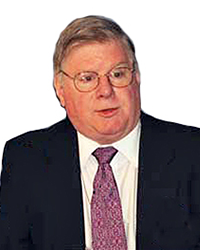A Tribute to Two BEA Researchers
Two Bureau of Economic Analysis (BEA) research economists, Bruce Taylor Grimm and Raymond John Mataloni Jr., died earlier this year. This tribute highlights their long careers and contributions to further develop BEA's statistical accounts.
Bruce Grimm

Grimm was a frequent contributor to the Survey of Current Business; his first contribution was a January 1982 article on domestic nonfinancial corporate profits, and his last was the May 2015 article “BEA Statistics and New Indicators of Economic Conditions,” coauthored with Assistant Chief Economist Benjamin R. Bridgman. In that 2015 Survey issue, then-BEA Director Brian C. Moyer noted how the authors “explain how BEA data… might shed light on emerging imbalances in the economy ahead of recessions.”
Grimm collaborated with BEA leadership to build the first research and development (R&D) satellite account in 1991. He and Carol E. Moylan, former associate director of BEA's Industry Economic Accounts, joined the System of National Accounts (SNA) Group and reported to then-BEA Director Carol S. Carson. “Bruce was instrumental in helping with the design of that account,” Moylan said. “He had a great understanding of both the U.S. national accounts and the international SNA [and] knew academic leaders in the field of R&D who could assist us,” Moylan added.
By the late 1990s, the R&D satellite account was established and Grimm went on to develop hedonic pricing models and methodologies to measure how rapidly advancing technologies, like computers and software, were impacting the U.S. economy.
Grimm authored and contributed to a number of working papers encompassing a range of topics: government organizations' price estimations, quality-adjusted price indexes for nonresidential structures, turning points in gross domestic product revisions, integrated environmental economic accounts, U.S. economic volatility, and alternative measures of business cycles, among others. When BEA organized hardcopy records to be digitized prior to its 2017 office move, Grimm's working papers filled an entire storage box.
After graduating from Dartmouth College in 1965, Grimm attended the University of Pennsylvania on a full National Defense Education Act fellowship, and in 1969, he earned a Ph.D. in economics. Before accepting a position at BEA in 1972, Grimm worked on defense-related projects at the Institute for Defense Analyses, including onsite work in South Vietnam.
Described as always cheerful, always methodical, Grimm is remembered fondly by his peers. “When I came to BEA from the Bureau of Labor Statistics, he was instrumental in my acclimation,” said BEA Chief Economist Dennis J. Fixler. “His oral histories of the methodologies of BEA were fascinating. He was an excellent economist and colleague,” Fixler continued. Moylan agreed, adding Grimm “was a great mentor” who exuded warmth and kindness.
Ray Mataloni

Mataloni helped design and run government surveys of U.S.-based multinational companies—surveys that continue to produce insightful economic data on global business trends. At the time of his passing, Mataloni was chief of the Research and Methodology Group for the International Economic Accounts. He is remembered for his innovative research, collaborative leadership style, and extensive knowledge of economic globalization.
“Ray was the lead author of Bureau reports and studies on U.S. direct investment abroad and the activities of U.S. multinational enterprises. His work informed policy debates and motivated much academic research in this area. He also devoted much effort to improving the quality of the Bureau's statistics on multinational enterprises,” said retired IED Research Economist William J. Zeile.
Obie G. Whichard, former IED associate director, concurred. Mataloni “brought innovation and expertise to BEA and to the international statistical and economic community,” where he was “widely recognized,” Whichard said.
At Organisation for Economic Co-operation and Development (OECD) forums, Mataloni connected with peers from around the world, including Mirco Lattwein. The deputy head of section for financial account and international investment position at Germany's Deutsche Bundesbank, Lattwein said Mataloni's expertise, deep knowledge during discussions, and open mind for other views during OECD meetings made a lasting impression on him. Mataloni and Lattwein later worked together on the International Monetary Fund Direct Investment Task Team.
An active member of the Academy of International Business, the American Economic Association, and the National Bureau of Economic Research Conference on Research in Income and Wealth, Mataloni also continued to be involved in academia. He was a fellow at the Global Scope Research Lab at George Washington University and an economics adjunct professor at the University of Mary Washington.
His work was published in the Survey as well as professional publications such as the Journal of World Business and the Review of Economic Statistics. He helped write a chapter for the 2021 book Global Goliaths: Multinational Corporations in the 21st Century Economy and wrote or coauthored several working papers on U.S. multinational firms, covering topics such as expansion strategies, intellectual property, offshore outsourcing, and productivity advantages.
— ♦ —
The many decades that Drs. Grimm and Mataloni researched and presented new and innovative ways to dive deeper into data further expanded and improved BEA's estimates. Their intellectual curiosity and enthusiasm for their respective fields of economic expertise benefited those at the Bureau and beyond.